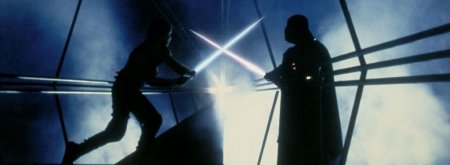The Name's Bond
James Bond has been in the spying business for such a long time that he really ought to be up for a long-service award. But the world’s most famous secret agent is going as strongly as ever. Since 1953, when Ian Fleming’s first 007 novel, Casino Royale, hit the shelves, Commander Bond has been suavely dealing with the enemies of freedom around the globe, both in print and on screen.

Image © Metro-Goldwyn-Mayer Pictures/Columbia Pictures/EON Productions. All rights reserved. Used by permission.
The Bond novels didn’t come to an end with Ian Fleming’s death in 1964. Kingsley Amis (under the name of Robert Markham) wrote Colonel Sun in 1968, then in the 1970s, Christopher Wood wrote novelisations of his screenplays for The Spy Who Loved Me and Moonraker. John Gardner continued the series during the ’80s and early ’90s, writing 16 Bond novels, including novelisations of Licence to Kill and GoldenEye. American writer Raymond Benson then wrote 9 books, including novelisations of Tomorrow Never Dies, The World is not Enough and Die Another Day, plus three short stories. In 2008, Fleming’s centenary was marked by Sebastian Foulks’s novel, Devil May Care, since which there has been one more Bond novel, Carte Blanche, written by another American, Jeffrey Deaver, in 2011, which sees Bond working in a new intelligence agency, rather than MI6. Besides these, there have also been the Young Bond series, written by Charlie Higson, and The Moneypenny Diaries trilogy, written by Samantha Weinberg under the name of Kate Westbrook.

Image © Metro-Goldwyn-Mayer Pictures/
Columbia Pictures/EON Productions
Used by permission.
Of course, it is the screen incarnations of James Bond that have captured countless imaginations and generated an enormous quantity of merchandising[1] over the last four decades. Sean Connery, George Lazenby, Roger Moore, Timothy Dalton, Pierce Brosnan, and Daniel Craig have brought the world’s most famous secret agent to life in 23 action-packed films, making it the longest-running film franchise (23 ‘official’ films from EON Productions, that is: there have been two other feature films: the 1967 spoof, Casino Royale , and the 1983 remake of Thunderball, Never Say Never Again, which saw Sean Connery return to the role). The first actor to play Bond was not Connery, however. American Barry Nelson has that honour, for a one-hour live production of Casino Royale for CBS in 1954. Then two years later Bob Holness (of Blockbusters fame) took on the 007 mantle in a radio dramatisation of Moonraker.
The Appeal of Bond
What gives Fleming’s character such enduring popularity? James Bond is a hero, an English gentleman and a connoisseur of fine things, as well as being a womaniser, a gambler, a thrill-seeker, a rule-breaker and a killer. Above all, he is a cinematic icon of coolness. Bond’s life is one long adventure, bursting with the thrill of the chase, exotic and extreme situations, fabulous cars, and beautiful girls. He’s far from being a standard-issue secret agent: a good spy needs to be so unremarkable that he or she is almost invisible. In contrast, 007 likes to do things in his own distinctive way. He typically strolls brazenly into a social situation to get the measure of his enemy – he announces his presence and waits for a response.

Image © Metro-Goldwyn-Mayer Pictures/Columbia Pictures/EON Productions. All rights reserved. Used by permission.
007 is not merely a hero; he’s almost a superhero – not because he has superpowers, but because he is consummately good at everything he does and is, in practice, almost invincible. In place of superpowers, on-screen Bonds have traditionally wielded a fabulous array of gadgetry: watches equipped with transmitters, lasers, or detonators; glass-shattering rings; exploding pens; autogyros; minisubs (even one disguised as a crocodile); and a frankly ridiculous invisible car. Many of the earlier gadgets were based on real spy technology – the attaché case containing a hidden folding sniper’s rifle in From Russia With Love (1963), for example. Some, like the Bell Jet Pack in Thunderball (1965), seemed outlandish but were real machines;[2] others, like the miniature underwater breathing device in the same film, were pure make-believe. Some were forerunners of real machines, like the Wet Bike in The Spy Who Loved Me (1977). 007’s cars have tended to brim with gadgets and have set petrol-head pulses racing since his first Aston Martin in Goldfinger (1964).
However, the Daniel Craig era has returned Bond to the way he’s portrayed in Fleming’s books: he is rooted in reality, he’s far from invulnerable, and the tools of his trade are realistic (even if not real). The only non-standard equipment in his Casino Royale Aston Martin DB-S is a defibrillator. Craig’s Bond may be realistic, but there is little or nothing about him that is ordinary.
Licence to Kill
The most obvious facet of James Bond’s life is the violence. It goes with his job description: he is not merely a spook, he has the famous ‘00’ number – a licence to kill on behalf of the British government. It means he is a top MI6 agent, with a duty to avert the greatest dangers facing Britain or even the world. From his first celluloid mission neutralising the evil Dr No (Dr No, 1962), through to the forthcoming Skyfall (2012), in which he has to save MI6 and ‘M’ (Judi Dench) herself, Bond fights for good and for freedom.

Image © Metro-Goldwyn-Mayer Pictures/Columbia Pictures/EON Productions. All rights reserved. Used by permission.
The greatest enemy in the earlier films was the ultra-secretive SPECTRE (Special Executive for Counter-intelligence, Terrorism, Revenge and Extortion), masterminded by arch-villain Blofeld. SPECTRE had no national allegiances, but pursued profit and power. Inevitably, it opposed the free (and wealthy) western world, and frequently held some or all of it to ransom. SPECTRE was unscrupulous and callous, as happy to sell its services to communist powers (one of its cells consisted of members of the much feared Russian unit, Smersh, or Smyert Spionen – ‘Death to Spies’) as to fight against them. Dr No himself was part of this organisation, and planned to cause havoc with American nuclear missiles solely to demonstrate SPECTRE’s ability and willingness to commit evil acts.
007’s later enemies included the Soviet Union, China, drug smugglers, and assorted megalomaniacs, including international terrorists and media baron Elliot Carver (Tomorrow Never Dies (1997)). These baddies have often reflected the political landscape of their times, but most of them are united in wanting power above all else. They are tyrants who have no qualms about expending the lives of their minions or killing countless civilians – no price is too high when ultimate power is the prize.

Image © Metro-Goldwyn-Mayer Pictures/Columbia Pictures/EON Productions. All rights reserved. Used by permission.
Some of James Bond’s ruthless opponents, though, are motivated by revenge rather than money and power – Alex Trevelyan in GoldenEye (1995), for example, and Silva (Javier Bardem) in Skyfall. Sometimes this drives Bond too, as in Die Another Day (2002) when he tracks down the person who betrayed him into the hands of the rogue North Korean Colonel Moon. In Licence to Kill (1989) Bond has his ‘00’ status revoked in an attempt to stop him pursuing a vendetta against the man who mutilated his friend Felix Leiter and killed Felix’s bride on their wedding day. And in Quantum of Solace (2008), Bond kills the local Chief of Police in revenge for killing Bond’s ally, Mathis.
Yet even when it gets very personal for Bond, his own battles are inevitably bound up with issues of much wider importance – heroin smuggling in Licence to Kill, the threat of a North Korean invasion in Die Another Day, and monopolising Bolivian water rights in Quantum of Solace. The stakes are always high: failure could result in many deaths – a vital perspective when 007 has a baddie in the sights of his gun. Cold killer he may be, but when James Bond’s adversaries are such remorseless fiends, intent on unleashing mayhem upon innocent people, he has no option. Without this ‘super-spook’, countless lives would be lost, but his cool, even casual, efficiency while performing this aspect of his job is chilling.

Image © Metro-Goldwyn-Mayer Pictures/Columbia Pictures/EON Productions. All rights reserved. Used by permission.
Until the Craig era, the violence of Bond films was of an over-the-top, comic-strip type. The body count was high, but most deaths were instant, blood free, and almost painless. Bond – or a glamorous Bond girl – was usually lined up for an agonising, drawn-out demise, but it was always the baddies who became the victims of their own dastardly plans. Martin Campbell’s reboot of the 007 franchise, though, brought more brutal and realistic violence than before. The scene from Casino Royale in which Le Chiffre tortures Bond is tough viewing, as is the scene in which Vesper Lynd drowns. Yet even now, the deaths of minor characters Bond films tend to be unrealistic and stylised.
The violence raises important questions. Is such murderousness appropriate? What effect does it have on the audience? In some ways, a Bond movie is no different from many classic tales: a great hero fights an evil foe; the foe almost gets the better of the hero; the hero comes back from the brink of disaster and destroys the foe; along the way many people get killed. But portraying this kind of narrative on the big screen easily ends up presenting violence as a thing to be enjoyed in itself. This was very often true in the pre-Craig films. Of course, there are many films which are far more brutal, but it would be wrong to see the violence in older Bond films as therefore less of a problem because it’s less graphic. Arguably, the reverse is true: when movies reveal violence as truly horrific, they reinforce our instinct that it is to be feared and avoided at all costs. On the other hand, sanitised violence – exciting and free of messy consequences – can be seductive.
Humans are rather ambivalent about violence. On the one hand, we are made in the image of God, so there is something in us that revolts against violence. On the other hand, we are also rebels against God, and that makes us capable of all kinds of wickedness (see Jeremiah 17:9) – more than we imagine. We are not as far removed from violent people as we might imagine. We can easily look respectable on the outside, but nurture very aggressive attitudes on the inside. Jesus pointed this out when he extended the scope of the Old Testament law to include attitudes and thoughts (Matthew 5:21–28). Which of us is not guilty of anger? Jesus says that we are as guilty before God as if we had committed murder.
Bond Girls
Another element of the Bond films that has been highly stylised is the ‘Bond Girls’. From the moment Ursula Andress stepped out of the sea as Honey Ryder in Dr No, every Bond movie has featured beautiful women to set male pulses racing. In all except The Living Daylights (1987) and Quantum of Solace, James has a sexual relationship with at least one woman, some of whom, of course, prove to be enemies.

Image © Metro-Goldwyn-Mayer Pictures/Columbia Pictures/EON Productions. All rights reserved. Used by permission.
James Bond’s coolness and sophistication, together with his charm and rugged good looks, make him irresistible to most women (notable exceptions being Rosa Klebb in From Russia With Love and Miranda Frost [3] in Die Another Day). Bond even seduces the lesbian Pussy Galore in Goldfinger, resulting in her becoming heterosexual. These women are often temporary havens in his turbulent existence. While he is in their arms, the hazards of life as 007 are pushed to one side. Perhaps, even more importantly, the loneliness of the spy’s life is temporarily forgotten.
The way that Bond relates to women has evolved over the years in line with changing attitudes in society. He has always been protective towards them, with more than a little old-fashioned chivalry in his attitude, but, especially in the earlier years, he was often rather chauvinistic. More significantly, the nature of the women themselves has changed to an extent: they have certainly become more independent and self-sufficient. By the time we get to Die Another Day, Halle Berry’s Jinx is presented to us as Bond’s equal in many respects. Although the two of them become lovers, she refuses to allow 007 to be protective of her – and yet Bond still has to rescue her.

Image © Metro-Goldwyn-Mayer Pictures/Columbia Pictures/EON Productions. All rights reserved. Used by permission.
It is Bond’s protectiveness towards women that once brought him true love. In the 1969 film, On Her Majesty’s Secret Service, he rescues the beautiful, but bored, Comtesse Teresa ‘Tracy’ di Vicenzo from her attempt to drown herself on a Portuguese beach. She turns out to be the daughter of crime boss Marc Ange Draco who offers 007 his assistance and £1 million if he will marry Tracy. Bond refuses, but falls in love with her and marries her anyway. His happiness is short-lived, though: as the newlyweds set off for their honeymoon, Bond’s archenemy Blofeld and his henchwoman Irma Bunt spray the car with bullets. Tracy is killed and Bond is heartbroken. In the opening sequence of For Your Eyes Only (1981), he is shown visiting her grave to leave flowers. Never again would Bond commit himself to a woman, but sexual relationships continue to be a very significant part of his life.
The Bible is clear from the outset that sex is part of what it is to be human. In Genesis 2, the first man, Adam, only finds a suitable partner when God makes the woman. ‘At last!’, Adam exclaims, ‘this is flesh of my flesh and bone of my bone.’ He instantly recognises that they were made for each other. There is something in us which longs for intimacy with the opposite sex – it’s how we were made. Bond feels that longing intensely – perhaps particularly because of his unsettled and dangerous life. But the Bible is equally clear about what God’s standard is: absolute faithfulness within marriage and no sexual relations whatsoever outside of it. Bond the womaniser seems to care about nothing other than his own gratification. There is little or no thought for the consequences of these casual sexual liaisons. Regardless of the potential physical consequences of sex, Bond seems oblivious of the emotional impact on his lovers or himself. He knows the distress of losing a lover all too well – he has grieved over other dead women besides Tracy (most notably Vesper Lynd) – but apparently cares nothing for how the women he seduces will feel afterwards.

Image © Metro-Goldwyn-Mayer Pictures/Columbia Pictures/EON Productions. All rights reserved. Used by permission.
Women may be tough and independent in 21st Century Bond movies, but they continue to be objects of male fantasy. Until Casino Royale, the title sequence always featured scantily clad, or naked, dancers, most often in silhouette against a swirling background. They may be largely veiled by the visual effects, but this can serve to heighten the eroticism. If the Bond movies have any message, it would seem to be, embrace sexual freedom and don’t worry about the consequences.
Bond the Role Model
While few people would claim James Bond as a role model, many fans secretly fantasise about being like him – I confess that I drive differently when I leave the cinema after seeing him in action. The violence and womanising may be an enticing fantasy, but they’re reprehensible in the real world. Yet in some ways he is a good model. He is a hero prepared to risk his life for others, and who works for the triumph of good over evil. He is wholeheartedly committed to what he does, he enjoys life, he makes a point of being the best at what he does, he’s a gentleman with rather better manners than many, and he is always calm in a crisis. The films are intended as escapist entertainment, but we cannot help picking up cues for life from what we watch. Those of us who love Bond films need to make sure we pick up the good ones and don’t start fantasising about the more questionable aspects of his on-screen existence.
Film title: Skyfall
Keywords: Heroism, freedom, violence, revenge, sex, women
Director: Sam Mendes
Screenplay: John Logan, Neal Purvis, Robert Wade
Starring: Daniel Craig, Javier Bardem, Ralph Fiennes, Naomie Harris, Bérénice Marlohe
Distributor: Sony Pictures Releasing (UK); Columbia Pictures (USA
Cinema Release Date: 26 October 2012 (UK); 9 November 2012 (USA)
Certificate: PG-13 (USA); 12A (UK) Contains moderate action violence and one use of strong language
References
[1] The Corgi Aston Martin DB5 (from Goldfinger) with bulletproof shield, rotating number plates, hydraulic rams on the bumpers, wheel hub scythes, and, of course, ejector seat was perhaps the first ‘must-have’ film-tie-in toy.
[2] The Bell Jet Pack was developed for the US military. It could take a man up to 200 m in the air and keep him airborne for four minutes.
[3] Miranda Frost does sleep with Bond but it seems clear that this is merely a means to an end and doesn’t spring out of any attraction to him.
Related articles / study guides
© 2012 Tony Watkins



